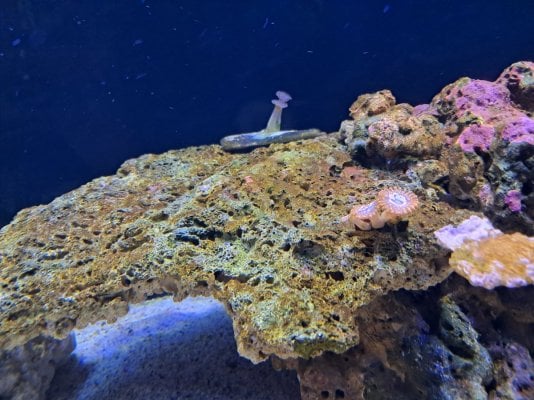Hello everybody.
*The tank is 8 months old. Started with live rock and live sand.
*I use RO/DI water, Aquaforest reef salt.
*Salinity: 1.024 - 1.025
*Alkalinity: 9 - 9.5
*Phosphate: 0.25 - 0.30
*NO3: 25 - 30
These parameters have been stable for several months.
*Living organisms: 2 clownfish, 1 watchman goby, 1 emerald crab, 3 nassarius snail.
*Corals: BTA, GSP, Pulsing xenia, Utter chaos zoa, Mushrooms, Candy cane coral, Gorgonian, and dying plate montipora.
For start, this nuisance is visually present after the first month, and I assumed it was never ending diatoms. But the past month it started growing on some corals and they won't open anymore.
The BTA, zoas, mushrooms and candy cane look like they are not affected by this nuisance, but this thing grows over the gorgonian, gsp, and the montipora. The xenia won't open as well.
What is this? I cleaned the sand 4 days ago when i did my last water change. Also when i syphon the sand it feels like the top brown layer is glued to the sand.
Thank you in advance.





*The tank is 8 months old. Started with live rock and live sand.
*I use RO/DI water, Aquaforest reef salt.
*Salinity: 1.024 - 1.025
*Alkalinity: 9 - 9.5
*Phosphate: 0.25 - 0.30
*NO3: 25 - 30
These parameters have been stable for several months.
*Living organisms: 2 clownfish, 1 watchman goby, 1 emerald crab, 3 nassarius snail.
*Corals: BTA, GSP, Pulsing xenia, Utter chaos zoa, Mushrooms, Candy cane coral, Gorgonian, and dying plate montipora.
For start, this nuisance is visually present after the first month, and I assumed it was never ending diatoms. But the past month it started growing on some corals and they won't open anymore.
The BTA, zoas, mushrooms and candy cane look like they are not affected by this nuisance, but this thing grows over the gorgonian, gsp, and the montipora. The xenia won't open as well.
What is this? I cleaned the sand 4 days ago when i did my last water change. Also when i syphon the sand it feels like the top brown layer is glued to the sand.
Thank you in advance.























